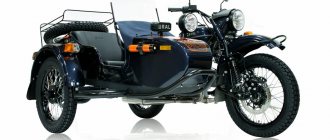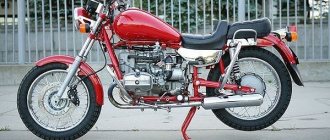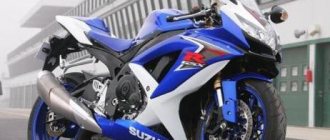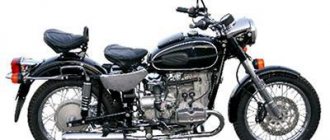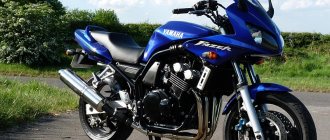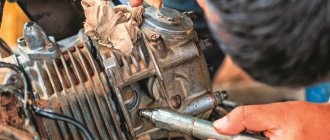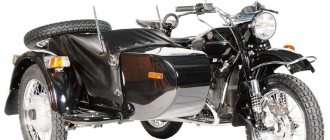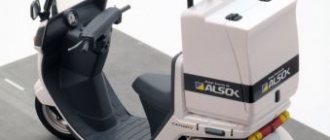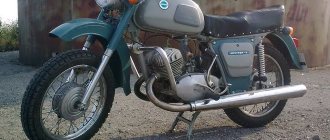Izh Jupiter-2
— a middle-class road motorcycle designed for riding on roads with different surfaces. Produced by the Izhevsk Machine-Building Plant. It was a continuation of the Izh Jupiter motorcycle series and was produced from 1971 to 1971. Then the engineers were faced with the task of making a new motorcycle with a two-cylinder engine. They succeeded.
The motorcycle turned out to be quite powerful (19 hp), the engine capacity of the motorcycle was 347 cm³. The battery was alkaline at 6V.
Izh Jupiter-2 was received well by motorcyclists, but then the opinion changed. The reason for this was the technical problems that arose in operation, in particular, the ignition angle on the motorcycle constantly went wrong over time, due to the negligence of crooked craftsmen who forgot to install engravers. The design of the motorcycle was not entirely successful: the main and glaring mistake of the designers was that on the gas tank, where the Izh badge usually stands, there was a badge with a drawn planet similar to Saturn, but not Jupiter.
| Type | Road | ||||||||||||||||||||||||||||||
| Components | |||||||||||||||||||||||||||||||
| |||||||||||||||||||||||||||||||
| Lubrication system | combined with fuel | ||||||||||||||||||||||||||||||
| Clutch | multi-disc, oil bath | ||||||||||||||||||||||||||||||
| checkpoint |
| ||||||||||||||||||||||||||||||
| Drive unit | roller chain, gear ratio - 2.22 | ||||||||||||||||||||||||||||||
| Fuel supply | by gravity | ||||||||||||||||||||||||||||||
| Front tire | |||||||||||||||||||||||||||||||
| Rear tire | |||||||||||||||||||||||||||||||
| Specifications | |||||||||||||||||||||||||||||||
| Tank capacity | |||||||||||||||||||||||||||||||
| Maximum speed, km/h | |||||||||||||||||||||||||||||||
| Dimensions | |||||||||||||||||||||||||||||||
| Motorcycle base, mm | |||||||||||||||||||||||||||||||
Specifications
- Engine Number of cylinders: 2
- Engine type: petrol
- Number of cycles: 2
- Gas distribution system: piston
- Cooling system: air, ram air flow
- Cylinder diameter: 61.75 mm
- Stroke: 58 mm
- Working volume: 347 cm 3
- Maximum power: 19 hp
- Compression ratio: 6.7-7.0
- Number of carburetors: 1
- Power system: Carburetor K-36ZH
- Engine fuel: a mixture of gasoline and oil in a ratio of 20/1 (during the break-in period) and 25/1 (for a broken-in motorcycle).
- Number of gears: 4
- Front wheel suspension type: conventional telescopic
- Fuel tank: 18
- Battery contact ignition
Notes
Wikimedia Foundation. 2010.
See what “Izh Jupiter-2” is in other dictionaries:
- This term has other meanings, see Jupiter. Jupiter Superior depicted ... Wikipedia
— “Jupiter and Thetis” (“Jupiter et Thétis”), artist Jean Ingres, 1811, oil, 330×257 cm. This term has other meanings, see ... Wikipedia
— “Jupiter and Thetis” (“Jupiter et Thétis”), artist Jean Ingres, 1811, oil, 330×257 cm. Jupiter (Latin Iuppiter) in ancient Roman mythology, the god of the sky, daylight, thunderstorms, king of the gods, supreme deity Romans Husband of the goddess Juno. Corresponds... ... Wikipedia
- (Jupiter). Roman deity corresponding to the Greek Zeus. He is the king of heaven, on whom all celestial phenomena depend, the ruler of the world, who controls the fate of peoples and states. He was considered the main patron of the Roman state; him... ... Encyclopedia of Mythology
JUPITER (astrological sign G), planet, average distance from the Sun 5.2 a. e. (778.3 million km), sidereal period of revolution 11.9 years, rotation period (cloud layer near the equator) approx. 10 h, equivalent diameter approx. 142,800 km, mass... ... Encyclopedic Dictionary
It is impossible not to exaggerate the contribution of the Izhevsk plant to the development of the motor industry. The first IZH models replenished and surprised the motorcycle fleet. “IZH Jupiter-2” is precisely the little one that, on its own two feet, endured all the hardships of the shortage of copies. “Jupiter” became not just a favorite of people, it still holds the high title of a legend in the motorcycle industry. A new design, good technical characteristics, endurance, strength, and most importantly, low cost - these are the components of popular success. "IZH Jupiter-2" can still be found on the roads. And there are many good reasons for this. So what kind of motorcycle is this? We need to start from the beginning.
Program for calculating phenomena in the Jupiter system Jupiter 2Among the small specialized programs, the program for calculating phenomena in the Jupiter system Jupiter 2
French developers Andre and Sylvain Rondi. The installation file version 2.0.7.1 dated May 8, 2009 can be downloaded from the authors’ website https://www.astrosurf.com/rondi/jupiter/index.htm. The size of the distribution is 1.6 MB, the size of the unpacked folder is 6.5 MB. The program is free and designed for the Windows operating system.
Let's launch the distribution. First, the installer asks you to select a language for the installation process. By default, select Russian (read from the system). Then you are prompted to select the working folder for the program, for example C:\Program Files\Jupiter 2. After agreeing to create shortcuts, the program completes its installation and can be launched. By the way, in the start menu of installed programs there is a shortcut to uninstall the program.
So, we have one of two main windows in front of us. It's in French. Unfortunately, there is no Russification, so we will switch to standard and understandable English. To do this, on the top panel in the Options option, select English from the proposed languages (French, Spanish, English, German, Italian, Portuguese) and in the same option save the parameters so that next time the English menu will be the default.
The About option displays in a drop-down window information about the program, its capabilities (in different languages) and developer contacts (website, email).
The Quit option allows you to both exit the program and save settings before exiting.
The first main Jupiter Satellites window shows us the relative positions of Jupiter's four Galilean satellites: Io, Europa, Ganymede and Callisto.
The control buttons are intuitive. Let's sort them out. The Date/Time window panel displays the date and time the program was started. They can be changed manually from the keyboard by placing the cursor in the desired position. The Now button gives the current static time. Under each date and time setting there are buttons to increase and decrease them. Clicking on the pluses and minuses causes a change in the visual picture of the relative positions of the satellites. The program works in the range from 1900 to 10000.
Time Zone allows you to set local standard time relative to Greenwich (for Moscow +3 hours). A little lower, in the gray windows, we see the universal time and Julian date.
The Control window panel allows you to move the time forward (Add) or back (Subtract) by minute, hour, day, month and year, as well as set the time step ratio (Value).
The Animation panel starts an animation of the passage of time with a set step. You can go to the future, or you can go to the past. Real Time button sets the current time. To go to a fixed time, press the pause button.
Turning on the checkboxes in the Display panel allows you to invert the image below in a mirror image in the east-west and north-south directions, adjusting the image to what is visible through a telescope or other optical instruments.
In a long black window we see a large-scale image of Jupiter covered with clouds and four satellites, which have different colors and name signatures, and in the upper right corner - directions to the cardinal points.
Below is a window with an enlarged Jupiter (Zoom) for the convenience of tracking phenomena in the giant planet’s system: satellites falling into the planet’s shadow (Ecl), passing behind the disk of Jupiter (Occ), passing along the disk (Pass), casting a shadow on the disk (Shad) . When the time changes, these events are displayed with check marks in the boxes opposite the satellites in the Events panel. The Key button in the drop-down window shows a legend of the images.
The Polar View window shows the location of the satellites relative to Jupiter from the north pole of the ecliptic (view from above). Moreover, the yellow circle depicts the direction to the Sun, and the short black line - to the Earth.
Below the Zoom screen shows the position of the Great Red Spot on the limb of Jupiter. The contour oval means that the BKP is currently on the far side of the planet. The absolute position of the BCP is entered manually. To do this, follow the hyperlink to a special website and look for longitude according to system II for a specific date. For the beginning of 2016, it is approximately 240 degrees.
At the bottom right, in the yellow windows of the Parameters panel, the following physical parameters are displayed: the position of the central meridian in system I (from the equatorial zone with a rotation period of 9 hours 51 m) and system II (from the high-latitude zone of the BKP with a rotation period of 9 hours 56 m), distance between Earth and Jupiter in astronomical units, distance between the Sun and Earth in AU, distance between the Sun and Jupiter in AU, equatorial diameter in arcseconds, phase angle in degrees, elongation in degrees, visibility conditions in points ( 0/5 - not visible or poorly visible, near conjunction, 5/5 - perfectly visible, near opposition), time of passage of the light signal between Earth and Jupiter in minutes.
Now let's move on to the second main Ephemeris window. Below we see the well-known graph of the positions of the satellites relative to Jupiter. The Key window explains the color codes in the graph. The chart can be presented for an eight-day interval, for one or two months (drawn by clicking on the corresponding buttons under the monthly calendar, on which the cursor sets the initial date of the chart). The scale can be stretched or compressed along the time axis or amplitude axis. There are Scale control buttons for this. Button 0 returns to the standard scale. The graph can be saved as a picture in different extensions (Save) or printed in portrait or landscape format (Print).
In the right part of the second main window, you can calculate the date and time of the passage of the BCP through the central meridian from the current moment (Now) or from midnight (Midnight). The calculation interval in days can be set manually (Extend of calculation). The Calculation button starts a calculation, the result of which is displayed in a yellow window. You can copy it, save it as text, or erase it.
As you can see, there is nothing complicated in managing the program. Despite the fact that the latest version was released almost 7 years ago, the program is quite simple and convenient. Jean Mees' algorithms, implemented in the program and providing high accuracy of calculations, make it possible to successfully predict events in the Jupiter system over large time intervals.
Sergey Belyakov (2016)
(The article was also published in the magazine “Nebosvod” No. 4/2016)
History of creation
The IZH Jupiter-2 motorcycle began its journey back in the distant sixties. The first copy was published in 1957. Then it could be seen at the world motorcycle exhibition under the simple and nondescript name “IZH”. The prototype of the future “Jupiter” was IZH-56. It was the single design of this motorcycle that became the basis for further linear two-wheeled transport.
Production of IZH Jupiter-2 began only in 1961. During mass production, this bike received its proud name, already known to everyone. The motorcycle existed for quite an impressive time. The last copy came out exactly ten years after the start of the launch - in 1971, IZH Jupiter-2 stopped descending from
Estimated cost
For obvious reasons, it is almost impossible to purchase a brand new IZH Planet 2 motorcycle, but it is quite possible to buy an old machine with a solid mileage or a well-restored bike with modern analogue parts.
On the Russian secondary car market, this model (depending on condition) is offered at a price from 10,000 to 30,000 rubles.
The cost depends on the condition, year of manufacture and mileage of the motorcycle.
Did you like the article? Tell your friends!
Novelty, or What the second “Jupiter” gave the world
The motorcycle differed little from its predecessors. Although there were technical and design differences. The new design is a separate topic, but the appearance of the model has been radically redesigned. Now “IZH Jupiter-2” began to look different. The electrical power supply circuit has also undergone modernization. New lighting required new wiring. By the way, about her.
There are few warning lights on a motorcycle. There is only a front round high beam headlight and a rear electric reflector. But by today's standards this is not enough. Therefore, modern motorcyclists riding a Jupiter are required by law to use side turn signals. The engine was also rebuilt.
Side-trailer version of the motorcycle
A sidecar or so-called cradle on a motorcycle provided a replacement for a car. The trailer could carry both one passenger and cargo, which is why this vehicle was quite popular in the Soviet Union. The model also had a rear compartment for a spare wheel.
By the way, some “home-made” from the Soviet Union saved on purchases and made cradles for their “Jupiters” from small beams and sheets of metal profiles, as well as from wooden boards.
It must be said that motorcycles with sidecars were used by the police until the beginning of the 21st century. They were equipped with liquid cooling, telescopic front forks and disc brakes instead of the usual drum brakes. They also had built-in radios and protective glass.
For public service, motorcycles from Izhevsky and Junker were usually converted. Nowadays, police officers patrol their areas in German BMWs. Strollers for the IZH “Jupiter-2” have become a rarity (you can see photos of them in our article).
- The motorcycle was first created by the German designer Gottlieb Deimer. He received a patent for it on September 29, 1885.
- Do you think airbags are only installed on cars? No, you are extremely mistaken! The airbags were first used on Honda motorcycles.
- In the twentieth century, motorcycle races were organized on the streets of residential areas. After several tragic consequences with pedestrians and racers, “high-speed chases” began to take place on specialized tracks.
- The USSR was one of the countries where motorcycles were produced in large quantities. In the world rankings, the Soviet Union took second place in this, losing to Japan.
- Actor Brad Pitt is seriously interested in collecting motorcycles. In his collection there is a motorcycle of our production - “Ural Tourist”. It is noted that the actor likes to go on motorcycle rides on this motorcycle.
- Few people know that to purchase a heavy motorcycle in Japan, you need to pass a strength test. It includes one test - raising the motorcycle from a recumbent position.
- Ernesto Che Guevara was a motorcycle enthusiast. He published the book “The Diaries of a Motorcycle Rider,” where he described his motorcycle travels.
"IZH Jupiter-2" - the photo will not deceive
The design of the bike is quite good for the sixties. IZH Jupiter-2 looks good. The photo cannot fully convey all the colors of the motorcycle. Large chrome exhaust pipes that run parallel to the ground immediately attract attention. A neat classic frame, there is nothing superfluous on it. The wheels are set shallowly in the wheel arches.
The compact engine, which can be seen in the middle of this picture, does not protrude from the sides. It’s worth saying a little more about the fuel tank. The teardrop shape looks as great as ever. Among the notable details are the round speedometer and the constant “Jupiter” inscription. Next to it is a picture of the planet itself.
Motorcycle type
“IZH 2 Jupiter”, like many of its “friends”, belongs to the type What is characteristic of it? Firstly, the main distinguishing feature of each “classic” is the straight fit. The seat is not moved back, not set low, it is level. This seat promotes a pleasant ride.
On a long road, in order not to get tired, you need to keep your back straight, only a classic motorcycle is capable of this. The pedals are not thrown forward. They are tucked under the driver. Thus, when supported, a right angle is formed. This doesn’t make your legs go numb, which is very important. The low steering wheel makes handling better. You don't have to reach far to grab the horns. The classic motorcycle feels good both on good roads and in poor surface conditions.
"IZH Jupiter-2" - characteristics
All the bells and whistles, the looks, the innovative details don't really matter. The only thing you should pay close attention to is the technical specifications. They can tell you about the bike what the shine hides. And so, the main center of any vehicle, and a motorcycle is one of them, is the engine. Therefore, the first thing you need to look at is the motor. IZH 2 Jupiter has a gasoline power unit, which is classified as a two-stroke system. This means that the pistons are lubricated by supplying the main fuel. That is, right at the gas station, in addition to gasoline, engine oil must also be poured into the fuel tank. At first glance there are a lot of details, but once you get used to it, you don’t notice it. The Jupiter engine has only two cylinders.
Their total volume is three hundred and forty-seven cubic centimeters. The IZh engine is capable of developing a power of nineteen horsepower. This is normal for a light motorcycle. The good old carburetor is responsible for supplying fuel. You should not forget the main thing: practical characteristics. “IZH 2 Jupiter” on relatively flat terrain is capable of reaching a speed of one hundred and ten kilometers per hour. Fuel consumption is low: four and a half liters of “eightie” per hundred kilometers of working distance. Jupiter is cooled using air currents. Not very effective, of course. But it was relevant for that time.
Design and reliability
IZH Planet 2, as evidenced by the number in the model name, became the second motorcycle in the Izhevsk Planet series.
It differs from the “ancestor” of the family in greater comfort and power of the power unit , as well as an updated, more modern (for that period of time) design.
Thus, Planet 2 received a signature paint job, a muffler and wheel rims covered with decorative chrome, a polished crankcase cover, as well as brake covers and a carburetor casing with a layer of hammer enamel.
The motorcycle seat has become wider and more comfortable. Its finishing is made of colored textinite.
The second generation model is designed in such a way that its repair does not require special or specific tools , conditions or equipment.
The mechanics are quite simple and straightforward , and spare parts are produced in abundance.
IZh Planet 2 owes its excellent cross-country characteristics to good traction at low speeds, high suspension and competent gearbox design.
Among other things, the owners of the bike unanimously declare the highest reliability of the engine and its amazing durability. This is confirmed by the manufacturer, who provided a warranty for a mileage of 15 thousand kilometers or a year and a half of operation.
Tuning a classic model
It's no secret that IZH 2 Jupiter was produced a long time ago. Not many people may like the old, worn-out look of a motorcycle; others want to see something of their own in this bike. There is only one way out - tuning, in simple terms - restructuring. Painting can be considered as one of the low-cost options. New bright colors will breathe a new soul into IZH 2 Jupiter. This will make the bike sparkle in completely new colors. Other craftsmen simply remove the stroller, if available. A lonely motorcycle looks much more impressive.
It is not for nothing that the IZH 2 Jupiter acquired the title of the people's motorcycle. Everything about it speaks of perfection.
Hai! If you are only interested in the electronics of this motorcycle, then you need our section “Motorcycle diagrams”. Those who are looking for a description with a photo based on reviews and technical characteristics of the Izh Jupiter 2 motorcycle, which you can buy today, then you have come to the right place. The article is devoted to the most important features of this bike, which has survived more than a dozen difficult years. Our team tried to fully reveal the advantages and disadvantages of this two-/three-wheeled vehicle.
Conditions of repair and operation
The motorcycle is designed in such a way that its repair does not require special conditions, tools or equipment. It is advisable, but not necessary, to have when assembling the engine and setting the ignition:
- solvent;
- tapping flathead screwdriver;
- metal brush;
- union heads;
- knob;
- compression gauge;
- micrometer;
- multimeter;
- a blowtorch (ideally, it is with its help that fingers are inserted into new pistons);
- scan at 14, etc.
It would seem that not every garage has a list of devices and tools. In fact, all of the above can be replaced with conventional tools. For example, press in the fingers using a bolt of the appropriate diameter and nut, and ring the wires or any electrical appliances with a 12-volt light bulb.
